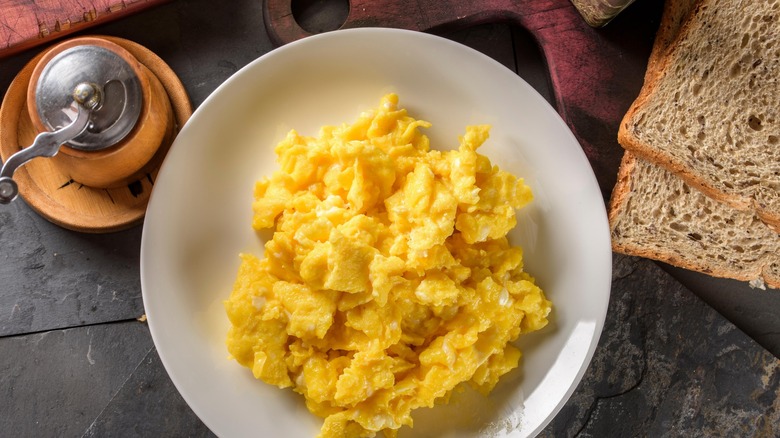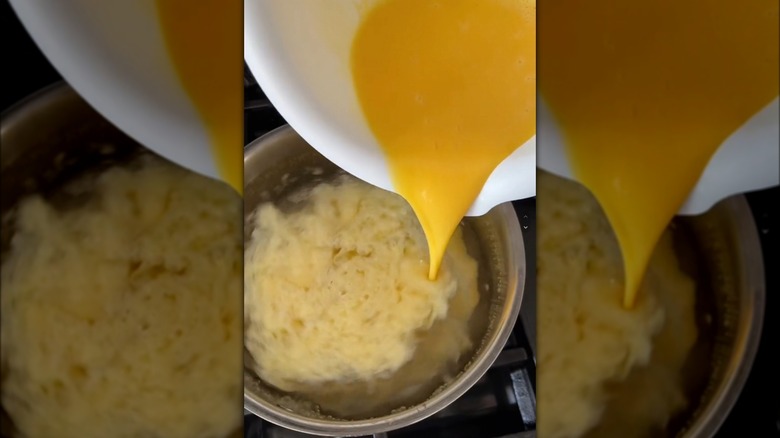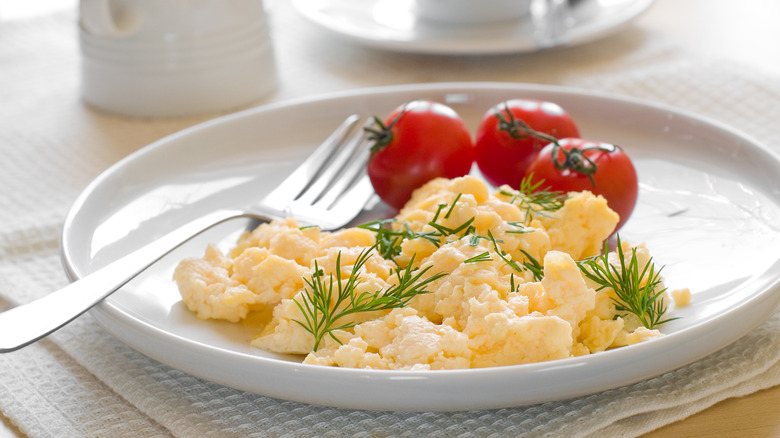Poaching Scrambled Eggs Is The New Reverse Sear
Scrambled eggs have managed to become such a staple at breakfast for one reason: simplicity. Beat the egg yolks until they turn into a golden slurry in a mixing bowl, then up-end it into a hot pan, and you have a tasty and filling meal to keep you fueled for the day ahead. But who says there's only one way to cook some fluffy scrambled eggs?
Certainly not Chef Daniel Patterson, the owner of the double-Michelin-starred restaurant Coi. He's thought up a pretty intriguing way to serve up a platter of this classic recipe, according to Food & Wine. Instead of the typical pan-frying with a drizzle of oil, the eggs are gently whisked and then poached in a whirlpool of simmering water. This technique not only matches the speed of frying, but also produces richer, creamier, and — most importantly — burn-free scrambled eggs, thanks to this gentler cooking approach.
Lots of people have taken note of this, too. It seems like poaching scrambled eggs is gaining as much attention from social media as reverse-seared steak once did, with TikTok videos popping up all over the place, hailing it as the new best way to make scrambled eggs. So, the question remains: Does this method truly live up to the hype?
How poaching can give you a fluffier scrambled eggs
To whip up a batch of poached scrambled eggs, start by whisking your eggs in a mixing bowl until they're silky smooth. Next, carefully pour this egg mixture into a pot of boiling water, stirring vigorously for about a minute. Then, put the lid on the pot and let the eggs steam for another minute. When you lift the lid and drain the water, you'll find your soft, pillowy scrambled eggs at the bottom of the pot.
The secret to why these eggs often turn out better lies in the cooking temperature. Traditional scrambled eggs are usually pan-fried on low to medium heat, with the eggy mix padded by a bit of cooking oil. Unlike boiling water, which never exceeds 212 degrees Fahrenheit, any cooking oil can easily exceed this temperature. That's why it's very easy to accidentally give your scrambled eggs a couple of browned spots using the traditional cooking method. Poaching is far gentler in comparison and allows the eggs to cook more evenly, giving you a scramble with a consistently soft and creamy texture, sans any of the scorching you might get from frying.
Dealing with waterlogged eggs
When experimenting with poached scrambled eggs, you might encounter a common issue: The eggs can turn out soggy rather than fluffy and pillowy after draining. In some cases, not only do the eggs absorb water, making them swollen and soggy; but they also tend to be less flavorful compared to traditional pan-fried scrambled eggs, which benefit from the flavors of the cooking oil.
Waterlogged eggs really can't be completely avoided because, after all, you just cooked them in a pot full of water. However, you can mitigate this by allowing the eggs to drain in a strainer for about 10 seconds after removing them from the pot. If they're exceptionally soggy, you might need to let them sit for up to a minute. To remove any remaining water, you can gently press the eggs with a spoon to squeeze out the excess moisture.
As for the taste, admittedly, poached scrambled eggs need quite a lot of seasoning for them to be palatable. Beyond just adding salt and pepper, consider adopting Daniel Patterson's approach by serving the eggs with a fresh goat cheese sauce and a drizzle of olive oil. The combination of creamy goat cheese and rich olive oil can give the eggs a significant upgrade in the flavor department, making them a far more wholesome meal that — going forward — can easily be your go-to scrambled egg recipe!


